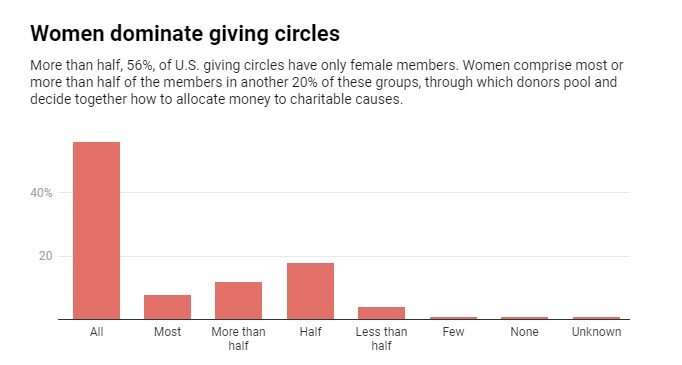Giving while female: Women are more likely to donate to charities than men of equal means

The American poet wrote in 1906 that a philanthropist is "a rich (and usually bald) old gentleman who has trained himself to grin while his conscience is picking his pocket."
While this satirical description may have resonated at the time, it no longer rings true today—in terms of the physical description if not the metaphorical critique. Major donors, people who give away massive sums of money, are becoming more diverse. More are women and .
As scholars of and , we've learned that , and these differences can be seen in a variety of ways.
Single or married, women give
are especially notable among single women and single men. Holding factors like income and wealth constant, about 51% of single women indicated they would give to charity, compared with 41% of single men. Women are also more likely than men to give to charity as their income rises.
MacKenzie Scott—who donated US$5.7 billion in 2020, more than any other American except for her ex-husband, Jeff Bezos—and other rich American women are .
nearly a dozen single female billionaires who have signed the Giving Pledge, a commitment to give more than half of their fortune to charity during their lifetime. Others include and .
Married women of means are also among today's most prominent philanthropists.
It's become more common and increasingly visible among the world's richest couples for women to and to champion causes of their own, like gender equality and criminal justice reform. Prominent examples include , who is married to Microsoft co-founder Bill Gates, and , the wife of hedge fund investor John Arnold.
Some women who are married to billionaires appear to be taking the lead on the couple's philanthropy. Examples include , a former Wall Street Journal reporter married to Dustin Moscowitz, co-founder of Facebook and Asana, and , the businesswoman who chairs the Starbucks board of directors and is married to "Star Wars" filmmaker George Lucas.
How women give
Of course, no one needs to be wealthy to be charitable.
And women, whether they're rich, poor or somewhere in between, are perhaps more likely than men to , participating in a variety of charitable activities.
and otherwise women seem especially likely to give by volunteering their , in addition to donating money to support causes they care about. Women are also likely to contribute in other ways, such as by engaging in advocacy and leveraging their social networks on behalf of these causes.
Research has shown that and and engage in less traditional forms of philanthropy, a trend that appears to have accelerated during the COVID-19 pandemic.
For instance, , which were originally established in Black communities in the 1700s, have reemerged to help individuals care for one another.
A study on that one of us (Skidmore) led showed that younger Americans were significantly more likely to participate in unconventional forms of giving, like making a special effort to order takeout to support local restaurants.
Women are more likely to give together
Women also show a greater preference for collective giving and other collaborative charitable efforts than men. .
, in which donors pool and decide together how to allocate money to charitable causes, have grown significantly in recent decades. A across the U.S. – approximately three times the number that existed in 2007.
as well, with more than 400 operating outside the U.S., including in Canada, Asia, the Pacific Islands and Europe.
In the U.S. and other countries, human services, education and women and girls are the .
Women are more likely to give online
Interestingly, our colleagues at the Women's Philanthropy Institute found in reviewing data from 2016 to 2019 that women give far more money online than men.
In particular, the researchers found that women gave about through the annual Giving Tuesday charity campaign, which happens on the Tuesday after Thanksgiving.
Happy ! Did you know that women are more likely to give on ? Women donors gave 64.7% of total dollars during last year's giving holiday. Learn more about how gender impacts :
— Women's Philanthropy (@WPIinsights)
Women everywhere are generous
There are many examples of affluent women giving generously elsewhere in the world too.
British author J.K. Rowling reportedly through the . The creator of the Harry Potter franchise established it in 2000 largely to .
In China, the landscaping entrepreneur pledged $1.5 billion for in 2017. That marked the biggest donation ever made for an environmental cause in any country at that point.
Liliane Bettencourt, who inherited the L'Oréal cosmetics and hair care fortune, established the , France's largest foundation. It primarily supports through prestigious prizes.
Japan's , Yoshiko Shinohara, recently retired to concentrate on philanthropy by funding scholarships for aspiring nurses, social workers or day care staff.
One reason women are able to give more money away today is that . The total amount of , by one estimate, up from $34 trillion in 2010.
So, contrary to Ambrose Bierce's take from a century ago, people don't need to be wealthy or male to be philanthropists.
Provided by The Conversation
This article is republished from under a Creative Commons license. Read the .![]()




















